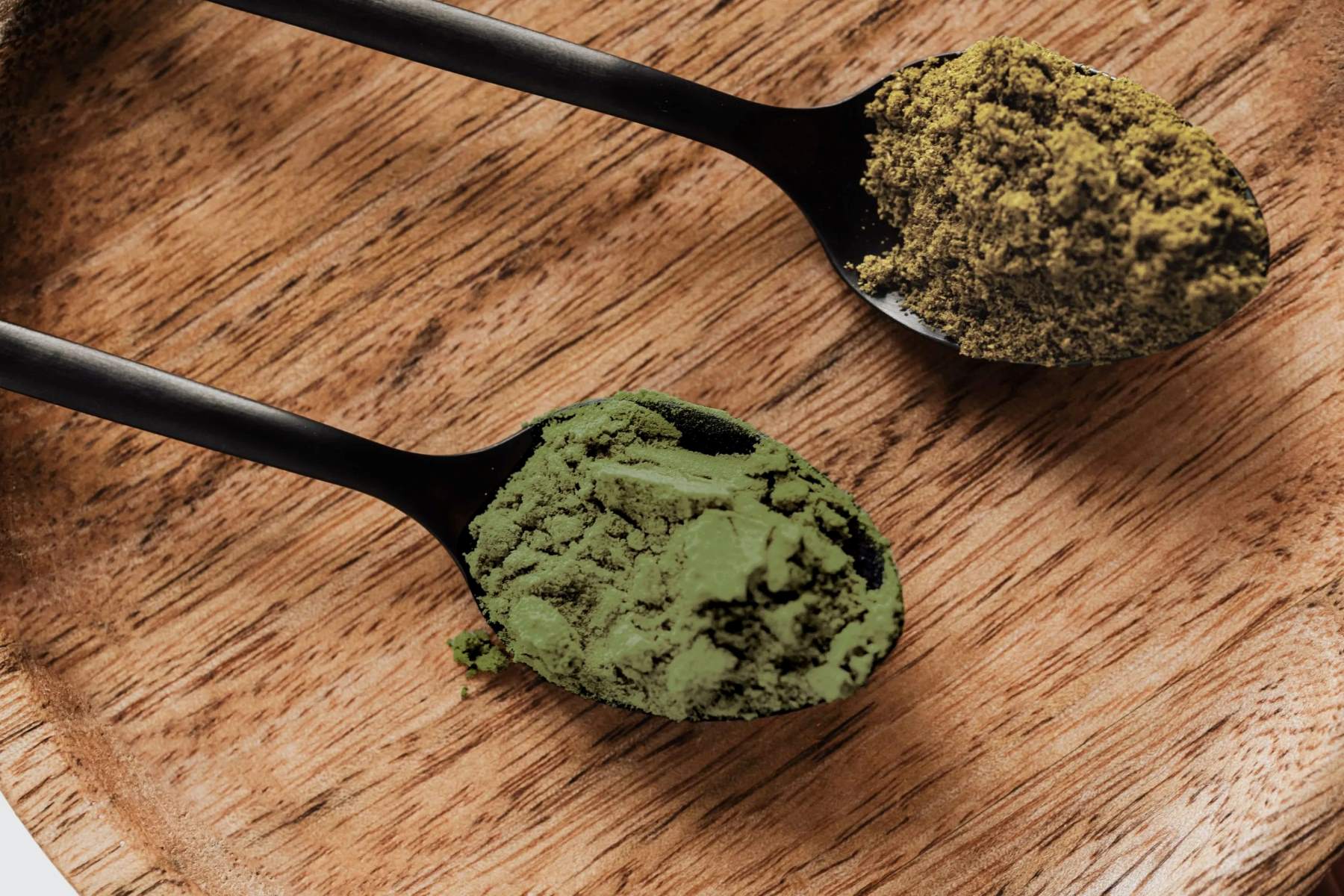Home>Health and Wellness>The Ultimate Showdown: Kava Vs Kratom – Unveiling The Key Differences


Health and Wellness
The Ultimate Showdown: Kava Vs Kratom – Unveiling The Key Differences
Published: January 27, 2024
Discover the key differences between Kava and Kratom to make an informed choice for your health and wellness. Uncover the ultimate showdown to find the best option for you.
(Many of the links in this article redirect to a specific reviewed product. Your purchase of these products through affiliate links helps to generate commission for Regretless.com, at no extra cost. Learn more)
Table of Contents
Introduction
Health and wellness have always been at the forefront of human interest. People are constantly seeking natural remedies to alleviate various health concerns and improve their overall well-being. In recent years, the popularity of herbal supplements has surged, with a particular focus on botanical products such as kava and kratom. These two natural substances have garnered significant attention due to their purported health benefits and unique properties.
Kava and kratom have distinct origins, cultural significance, and applications, making them intriguing subjects for exploration. Understanding the differences between these two botanicals is crucial for individuals seeking to incorporate natural remedies into their wellness routines. By unveiling the key disparities between kava and kratom, individuals can make informed decisions regarding their usage and potential impact on their health.
As we delve into the world of kava and kratom, it's essential to approach this comparison with an open mind and a desire to gain comprehensive knowledge. Through this exploration, we aim to shed light on the nuanced characteristics of kava and kratom, providing valuable insights that can empower individuals to make informed choices regarding their health and wellness practices. Let's embark on this journey to unravel the distinctive features of kava and kratom, gaining a deeper understanding of their respective properties and potential effects on the human body.
Understanding Kava
Kava, scientifically known as Piper methysticum, is a plant native to the South Pacific islands, where it has been a fundamental component of traditional ceremonies and social gatherings for centuries. The plant's roots are used to create a potent beverage that has been cherished for its calming and euphoria-inducing properties. Kava has also gained recognition in the Western world, where it is often consumed as a natural remedy for stress, anxiety, and insomnia.
The preparation of kava involves grinding the plant's roots into a fine powder, which is then mixed with water to produce a muddy, earthy-tasting beverage. This traditional kava drink, often referred to as "kava tea," is consumed to induce a sense of relaxation and tranquility. It is important to note that kava's effects can vary depending on the cultivar and the specific chemical composition of the root.
Kava's psychoactive properties are attributed to compounds called kavalactones, which interact with the brain's neurotransmitters to produce its characteristic calming effects. These effects are distinct from those of alcohol or sedatives, as kava does not typically impair cognitive function or cause significant drowsiness when consumed in moderation.
In addition to its potential anxiolytic and sedative properties, kava has been the subject of scientific research investigating its efficacy in managing anxiety disorders. Some studies have suggested that kava may offer benefits comparable to certain pharmaceutical interventions for anxiety, albeit with fewer side effects. However, it is crucial to note that the regulatory status of kava varies across different countries, and its safety and potential interactions with other substances should be carefully considered.
Moreover, kava holds cultural significance in the South Pacific, where it is deeply rooted in traditional practices and rituals. The consumption of kava is often accompanied by ceremonial protocols, emphasizing its role as a symbol of community, unity, and spiritual connection. This cultural context adds a layer of richness to the understanding of kava, highlighting its multifaceted significance beyond its pharmacological properties.
In essence, kava represents a fascinating botanical specimen with a rich cultural heritage and potential therapeutic applications. Its unique properties and cultural significance make it a subject of enduring interest and continued exploration in the realms of health, wellness, and traditional practices.
Understanding Kratom
Kratom, scientifically known as Mitragyna speciosa, is a tropical evergreen tree native to Southeast Asia, particularly in countries such as Thailand, Malaysia, and Indonesia. The leaves of the kratom tree contain naturally occurring compounds, including alkaloids such as mitragynine and 7-hydroxymitragynine, which are believed to produce various physiological effects when consumed.
For centuries, kratom has been an integral part of traditional practices in Southeast Asia, where it has been used for its stimulating and sedative properties. In its countries of origin, kratom leaves are often chewed or brewed into teas to impart a sense of alertness, alleviate discomfort, and enhance sociability. The cultural significance of kratom in these regions underscores its enduring role as a botanical agent deeply intertwined with local customs and rituals.
In recent years, kratom has garnered attention in the Western world, where it is often promoted as a natural remedy for managing pain, boosting energy, and alleviating stress and anxiety. Kratom supplements, available in various forms such as powders, capsules, and extracts, have become increasingly accessible to consumers seeking alternative approaches to wellness and symptom management.
The potential effects of kratom are attributed to its interaction with opioid receptors in the brain, which can result in analgesic and mood-altering outcomes. Additionally, kratom's stimulating properties are linked to its ability to influence neurotransmitter activity, contributing to increased alertness and sociability in some individuals.
It is important to note that the regulatory status of kratom varies across different regions, with some areas imposing restrictions or outright bans on its sale and consumption due to concerns about potential adverse effects and abuse. Furthermore, the scientific community continues to investigate the safety and efficacy of kratom, particularly in light of reported cases of dependence and withdrawal associated with its prolonged use.
The complex nature of kratom, encompassing its cultural significance, traditional applications, and contemporary interest as a natural supplement, underscores the need for a comprehensive understanding of its properties and potential impact on individual health and well-being. By delving into the multifaceted aspects of kratom, individuals can gain valuable insights into this botanical specimen's historical roots, pharmacological characteristics, and evolving role in the realm of health and wellness.
The Key Differences
Kava and kratom, despite both being natural botanicals with potential health applications, exhibit stark differences in their origins, cultural significance, chemical composition, and effects on the human body. Understanding these distinctions is crucial for individuals considering the use of these substances for wellness purposes. Here are the key differences between kava and kratom:
Origin and Cultural Significance
- Kava: The roots of the kava plant have been integral to the social and ceremonial practices of South Pacific island cultures for centuries. Kava holds deep cultural significance, often being consumed during rituals, gatherings, and traditional ceremonies, symbolizing community bonding and spiritual connection.
- Kratom: Indigenous to Southeast Asia, kratom has been historically intertwined with local customs and traditional practices in countries such as Thailand and Malaysia. It has been utilized for its stimulating and sedative properties, playing a role in social interactions and cultural rituals in its countries of origin.
Chemical Composition and Active Compounds
- Kava: The active compounds in kava are primarily kavalactones, which interact with neurotransmitters in the brain to induce relaxation and euphoria. These compounds are responsible for kava's anxiolytic and sedative effects, contributing to its potential as a natural remedy for stress and anxiety.
- Kratom: Kratom contains alkaloids such as mitragynine and 7-hydroxymitragynine, which interact with opioid receptors in the brain, resulting in analgesic and mood-altering effects. Additionally, kratom's stimulating properties are associated with its influence on neurotransmitter activity, contributing to increased alertness and sociability in some individuals.
Preparation and Consumption
- Kava: Traditionally, kava is prepared by grinding the plant's roots into a fine powder, which is then mixed with water to create a muddy beverage. This traditional kava drink, often referred to as "kava tea," is consumed to induce a sense of relaxation and tranquility.
- Kratom: Kratom leaves are traditionally chewed or brewed into teas in Southeast Asia. In the Western world, kratom is commonly consumed in the form of powders, capsules, or extracts, offering a more convenient and accessible means of consumption.
Legal Status
- Kava: The legal status of kava varies across different regions, with some countries imposing restrictions due to concerns about potential hepatotoxicity. In contrast, other countries have established regulatory frameworks to ensure the safe consumption of kava products.
- Kratom: The legal status of kratom is a subject of ongoing debate and regulatory scrutiny in various parts of the world. Some regions have implemented restrictions or outright bans on kratom due to concerns about its potential for abuse and adverse health effects.
In summary, the key differences between kava and kratom encompass their cultural heritage, active compounds, modes of consumption, and legal status. By comprehensively understanding these disparities, individuals can make informed decisions regarding the potential use of kava or kratom as part of their wellness practices, taking into account the distinct properties and cultural contexts of these natural botanicals.
Effects on the Body
The effects of kava and kratom on the human body are characterized by distinct physiological and psychological responses, reflecting the unique properties of these botanical substances. Understanding how kava and kratom interact with the body is essential for individuals considering their potential use for wellness purposes. Here, we delve into the specific effects of kava and kratom on the body, providing insights into their respective impact on human physiology and mental well-being.
Kava:
Kava is renowned for its anxiolytic and sedative effects, which stem from the interaction of its active compounds, primarily kavalactones, with neurotransmitters in the brain. When consumed, kava can induce a sense of relaxation, alleviate stress and anxiety, and promote a state of tranquility. These effects are often described as calming without significant impairment of cognitive function, making kava an appealing natural remedy for individuals seeking relief from emotional tension and mental unease. It's important to note that the specific effects of kava can vary based on factors such as the cultivar and the individual's physiological response.
Kratom:
The effects of kratom on the body encompass a broader spectrum, influenced by its diverse alkaloids and their interactions with opioid receptors and neurotransmitters. Kratom's primary alkaloids, such as mitragynine and 7-hydroxymitragynine, contribute to its potential analgesic, mood-altering, and stimulating properties. When consumed, kratom can alleviate discomfort, enhance sociability, and promote a sense of alertness. However, it's crucial to recognize that kratom's effects can vary widely among individuals, and its impact on physical and mental well-being is subject to ongoing scientific inquiry and regulatory evaluation.
By understanding the distinct effects of kava and kratom on the body, individuals can gain valuable insights into the potential physiological and psychological responses associated with their consumption. These effects play a pivotal role in shaping the perceived benefits and considerations related to the use of kava and kratom for wellness and symptom management. It is imperative for individuals to approach the exploration of these effects with mindfulness and a comprehensive understanding of the nuanced interplay between botanical substances and the human body.
Legal Status
The legal status of kava and kratom is a multifaceted subject influenced by regional regulations, cultural perceptions, and ongoing scientific discourse. Understanding the legal framework surrounding these botanical substances is crucial for individuals considering their potential use and navigating the complexities of their availability and consumption.
Kava:
The legal status of kava varies significantly across different regions and countries. In some areas, concerns regarding potential hepatotoxicity have led to restrictions on the sale and consumption of kava products. These regulatory measures are aimed at safeguarding public health and mitigating potential risks associated with the consumption of kava-based beverages and supplements. However, it is important to note that other regions have established regulatory frameworks to ensure the safe and responsible use of kava, recognizing its cultural significance and potential therapeutic applications. This nuanced approach acknowledges the historical and ceremonial importance of kava in certain communities while addressing concerns about its safety and potential health implications.
Kratom:
The legal status of kratom is a subject of ongoing debate and regulatory scrutiny in various parts of the world. Due to concerns about its potential for abuse, adverse health effects, and interactions with other substances, some regions have implemented restrictions or outright bans on the sale and consumption of kratom products. This regulatory stance reflects the evolving understanding of kratom's pharmacological properties and its potential impact on public health. However, it is important to recognize that the legal status of kratom is not uniform globally, with differing approaches and perspectives shaping the accessibility and utilization of kratom-based supplements and preparations.
The legal status of kava and kratom is intertwined with broader discussions surrounding herbal supplements, natural remedies, and public health considerations. As regulatory frameworks continue to evolve, it is essential for individuals to stay informed about the legal landscape governing the availability and usage of kava and kratom in their respective regions. By fostering awareness of the legal status of these botanical substances, individuals can make informed decisions regarding their potential incorporation into wellness practices while respecting the diverse perspectives and regulatory measures shaping their accessibility and cultural significance.
This comprehensive understanding of the legal status of kava and kratom serves as a foundation for navigating the complexities of their availability, ensuring responsible usage, and fostering informed dialogue surrounding their role in the realm of health and wellness.
Conclusion
In conclusion, the comparison between kava and kratom reveals a rich tapestry of cultural significance, pharmacological diversity, and regulatory considerations. These botanical substances, originating from distinct geographical regions and deeply rooted in traditional practices, offer unique properties and potential health benefits that captivate the interest of individuals seeking natural remedies and wellness practices.
The exploration of kava unveils a plant with a profound cultural heritage in the South Pacific, where it has been revered for its role in fostering community bonds, spiritual connection, and relaxation. Kava's active compounds, kavalactones, interact with neurotransmitters to produce anxiolytic and sedative effects, positioning it as a potential natural remedy for stress and anxiety. However, the legal status of kava varies across different regions, reflecting concerns about its safety and potential hepatotoxicity.
On the other hand, kratom, originating from Southeast Asia, embodies a botanical specimen with stimulating and analgesic properties deeply intertwined with local customs and traditional practices. The alkaloids present in kratom, such as mitragynine and 7-hydroxymitragynine, interact with opioid receptors and neurotransmitters, contributing to its diverse physiological effects. The legal landscape surrounding kratom is characterized by ongoing debates and regulatory scrutiny, reflecting the evolving understanding of its potential impact on public health and well-being.
The distinctive effects of kava and kratom on the human body underscore the nuanced interplay between botanical substances and physiological responses. While kava is renowned for inducing relaxation and tranquility, kratom offers a broader spectrum of effects, including analgesia, mood alteration, and increased alertness. Understanding these effects is essential for individuals considering the potential incorporation of kava or kratom into their wellness routines, fostering informed decision-making and mindful usage.
Furthermore, the legal status of kava and kratom reflects the intersection of cultural heritage, public health considerations, and regulatory measures. As individuals navigate the availability and usage of these botanical substances, staying informed about regional regulations and fostering responsible practices is paramount to honoring their cultural significance and potential therapeutic applications.
In essence, the comparison between kava and kratom unveils a dynamic landscape shaped by cultural traditions, pharmacological diversity, and regulatory dynamics. By embracing a comprehensive understanding of these botanical substances, individuals can navigate the complexities of their potential usage, fostering informed dialogue, and respecting the multifaceted perspectives that enrich the realm of health and wellness.












